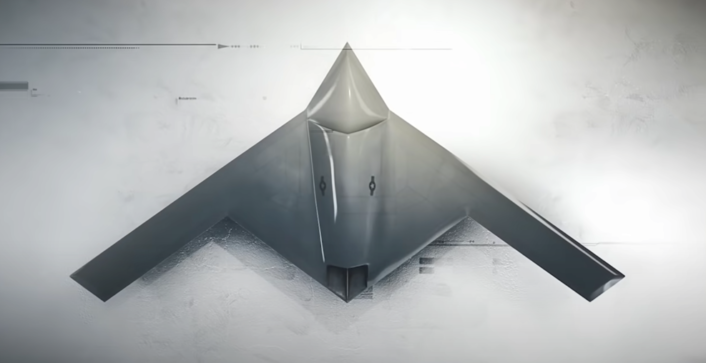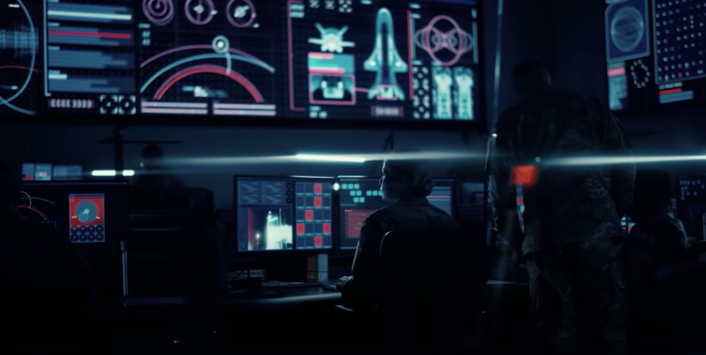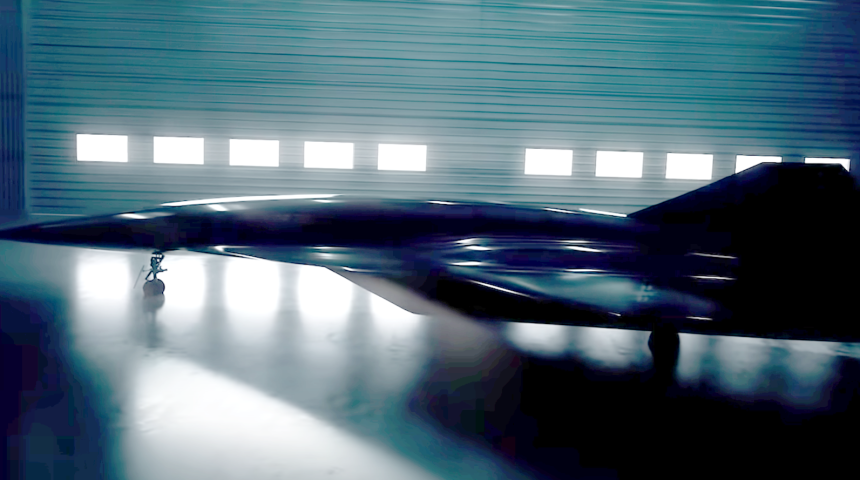Several interesting projects are featured in a short promotional video, including the secretive SR-72 and the RQ-180.
A video, published on Youtube on Nov. 8, 2021, by the U.S. Air Force Profession of Arms Center of Excellence (PACE) under the title “Heritage Today – ISR and Innovation” provides a new look at some of the most interesting and secretive U.S. ISR (Intelligence Surveillance Reconnaissance) projects.
The less than 3 minutes clip is an overview of the evolution of the ISR mission since the beginning. At the 2:25 mark, after showing a flying RQ-4 Global Hawk, the video focuses on a stealthy flying-wing drone whose planform appears to be similar to the artworks published on the front cover of Aviation Week & Space Technology when the project was unveiled in 2013. The planform image is introduced by the following commentary: “The days of balloons and biplanes have been replaced by white bats,” and considered that the RQ-180 is nicknamed the “Great White Bat” (or sometimes “Shikaka”, a fictional sacred white bat from the 1995 movie Ace Ventura 2), the appearance of the cranked kite design clearly alludes to the new clandestine spy drone.
Still, it’s worth noticing that the shape of the drone featured in the latest USAF video does not fit the one of the unmanned aircraft, believed to be indeed a real RQ-180, spotted over California, last year, and the Philippines earlier this year. In other words, we are probably not shown the actual RQ-180 but something loosely similar to it, in preparation of a somehow official unveiling.

However, the one of the “”White Bat” is not the only interesting “cameo” or easter egg you can find in the video.
The really interesting one, comes later, at the 2:34 mark, when the video cuts to the dark image of a sleek and stealthy aircraft in a hangar that seems to match the shape of the SR-71 successor, also unofficially dubbed the “Son of Blackbird“, the Lockheed SR-72.
The SR-72 is an unmanned hypersonic intelligence, surveillance and reconnaissance and strike platform designed for Mach 6. Very little is known about this aircraft besides some alleged sightings, rumoured every now and then, and the presumed date for a first flight possibly in 2025.
Again, the one in the USAF clip is probably just a computer-generated image, with many different details and possibly a significantly different shape than the real thing; still it’s worth of remark since it is one of the very few (somewhat official) allusions to the new aircraft that the service has done since the program was revealed. For the records, the SR-72 was featured in a poster issued by the Air Force in 2017 for the 70th anniversary of the service, that you can find here: the shape appears to be pretty much the same as the mysterious aircraft in the latest video.
Interestingly, the video also shows the outline of the secretive X-37B spaceplane in a display of what seems to be a command center.

We have wrote a lot about the X-37B in the past here at The Aviationist. Here below you can find an excerpt with some of the key facts and some theories about the missions it carries out:
The Air Force’s X-37B began as a test project with NASA in 1999 but was acquired by the U.S. Department of Defense in 2004. Most sources list two operational X-37B spacecraft and a single X-37A. The fact that only three exist, their missions and roles are classified and they operate in space makes them incredibly difficult to get photos of, especially when performing an active mission as in Vandebergh’s photos.
Little is known about the current role of the two X-37Bs and the single X-37A. Most likely the X-37Bs are in some form of “operational test” use with the USAF while the X-37A reportedly remains a combined Defense Advanced Research Projects Agency (DARPA) and NASA spacecraft with an equally secretive role.
While most information in the public domain lists both the X-37B and X-37A as “test” vehicles, the X-37B has performed unusually long duration space flights for testing.
Three theories [about the type of missions the X-37B has carried out thus far] have prevailed:
The first theory is that the X-37B is a space-based weapons platform. The spacecraft is pre-deployed into orbit armed with some type of weaponized re-entry vehicle that could be released over or near a specific target. It may also be a weapons delivery vehicle deployed in defense of space-based commercial assets such as the GPS satellite constellation. This theory is debunked by most analysts.
Secondly, and most plausibly, the spacecraft may be a platform for gathering intelligence. This could include signals intelligence such as activities of communications and surveillance satellites, both civilian and military. With approximately 2,271 satellites in orbit around the earth at various altitudes performing a wide variety of functions this theory tends to be the most realistic. It may also be ground mapping radar and other surveillance mediums. Since the large internal payload bay of the X-37B, about the size of the interior of a small general aviation aircraft such as a Cessna Caravan, is interchangeable the spacecraft could be “mission adaptive”, meaning it could be reconfigured for various types of surveillance. That this last mission was so long in duration suggests the X-37B may have had a means of transmitting intelligence from space back down to earth, somehow beyond the capabilities of existing space based surveillance platforms like satellites.
Lastly, and most unlikely, the X-37B remains a research project. It could potentially be a test bed for deploying satellites and servicing them robotically in space, releasing new orbital packages into space or any number of other roles not yet performed operationally. Given the duration and investment into the program along with the operational security surrounding it this theory seems least likely. A major part of X-37B operations are administered by DARPA, the Defense Advanced Research Projects Agency, a shadowy U.S. government agency located in Arlington, Virginia.









